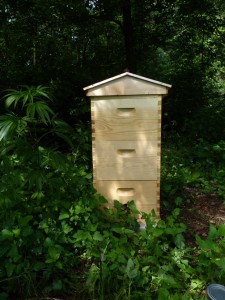Lughnasa Waning Artemis Moon
The waning Artemis moon has a golden hue tonight, honey colored, as it sits on the northeastern horizon. A band of clouds created two dark lines, parallel to each other and about a third of the way down. It looked like a view of the moon from an ukiyo-e print.
We have bottled our first honey. Those four frames from the package colony, not even full frames at that, yielded almost a full gallon of honey. We strained it through a coarse, medium and fine filter and put it into half pint jars for the most part. It looks beautiful and very satisfying. Artemis Hives has begun to produce. I think I’ll tip a half-pint out in the woods to honor the namesake goddess.
Tomorrow I’ll work first on the divide, since I know it has very little honey in the supers. It plugged up the third hive box with honey back in late May, early June. After that I’ll move to the parent colony. The parent colonies produce the most honey because they are vigorous and are not storing honey for the next year. It will be interesting to see how much we get from the parent colony since next year, if everything goes well, we’ll have two parent colonies and two divides. Four colonies should produce plenty of honey for our own use and to give as gifts.
It’s going to be hot with dewpoints in mid-70s. That’s good for working with the honey because it flows well when the temperatures are high; that’s bad for working with the bees because I have to wear a veil at least.
We bolted the honey extractor to the deck instead of using the honey house. Did that for a couple of reasons. First, it’s much further from the colonies and second, it’s much closer to the kitchen. Also, the mess, and it is a messy process, can be contained with drop cloths.

 Lughnasa Waning Artemis Moon
Lughnasa Waning Artemis Moon